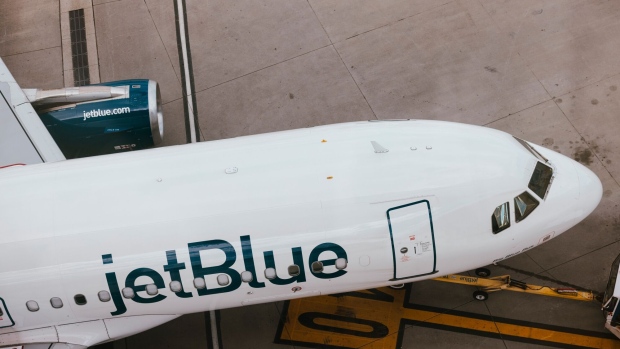Apr 23, 2024
JetBlue’s Quarterly Revenue Outlook Misses on Latin America Woes
, Bloomberg News

(Bloomberg) -- JetBlue Airways Corp.’s shares fell the most since the early days of the pandemic after the carrier forecast worse-than-expected sales this quarter, blaming excess flying capacity in the critical Latin America market.
Second-quarter revenue will decline as much as 10.5% year over year, the carrier said in a statement Tuesday as it reported first-quarter earnings. Analysts were expecting a drop of 3.8% on average, according to estimates compiled by Bloomberg. Non-fuel unit costs, including expenses from a new pilot contract, will climb as much as 7.5%, more than Wall Street had anticipated.
The guidance for the quarter and full year “were not nearly as strong as recently reported results from some of the carrier’s full-service peers,” Stephen Trent, a Citi analyst, said in a note. That could cause JetBlue “to relinquish some of its recent share price gains.”
The shares fell 13% at 9:40 a.m. in New York after an earlier drop of 20%, the biggest intraday slide since March 2020. The decline pulled down other airlines. JetBlue’s stock climbed 35% this year through Monday.
The carrier joins larger rivals Delta Air Lines Inc. and United Airlines Holdings Inc. in reporting weaker sales in Latin America after carriers overloaded the market with too many flights, particularly to leisure destinations, which is holding fares down. Delta and United both have said they expect improvement in the region during the second half of this year.
Latin America is about 35% of JetBlue’s flying, and industry capacity is up 60% over 2019 levels, Dan McKenzie, a Seaport Research Partners analyst, said in a report. An expected revenue increase in the market has not materialized, he said.
“As we look to the full year, significant elevated capacity in our Latin region, which represents a large portion of JetBlue’s network, will likely continue to pressure revenue and we expect a setback in our expectations for the full year,” JetBlue Chief Executive Officer Joanna Geraghty said in the statement.
The airline’s total capacity will slide as much as 5% this quarter from a year ago, and will fall by low single digits for the full year.
Full-Year Miss
JetBlue’s outlook for 2024 revenue to decline in the low single digits from 2023 also falls short of Wall Street’s expectations for a small increase. Non-fuel unit costs will increase in the mid- to high-single digits for the year, while analysts were expecting growth of 3.4%.
The outlook comes as Geraghty works to counter persistently high costs and plot JetBlue’s future as an independent carrier.
The airline earlier this year delayed some $2.5 billion in planned aircraft spending and announced plans to cut unprofitable routes. Roughly two months in the top job, Geraghty is steering the airline through an uncertain time after federal courts blocked an alliance with American Airlines Group Inc. and JetBlue’s $3.8 billion purchase of Spirit Airlines Inc.
The CEO has said her top priority is returning to consistent profits, which the carrier hasn’t seen since 2019. JetBlue said its cost-reduction program achieved about $100 million in structural cost savings to date, on track to have run-rate savings of $175 million to $200 million by the end of 2024.
The executive team is working under scrutiny from activist investor Carl Icahn, who in February revealed a roughly 10% stake and began pushing to boost shareholder value. The company has since given his investment firm two board seats.
The forced grounding of some of its planes is also limiting growth. JetBlue has said it expects an average of 11 aircraft to be out of service throughout the year because of a manufacturing defect in engines made by RTX Corp.’s Pratt & Whitney unit. That should peak at 13 to 15 parked planes at the end of 2024, the carrier has said.
JetBlue’s first-quarter adjusted loss of 43 cent a share was better than the average deficit of 52 cents expected by analysts, based on estimates compiled by Bloomberg. Revenue of $2.21 billion just topped Wall Street expectations for $2.20 billion
(Updates with opening share price in first, fourth paragraphs)
©2024 Bloomberg L.P.


